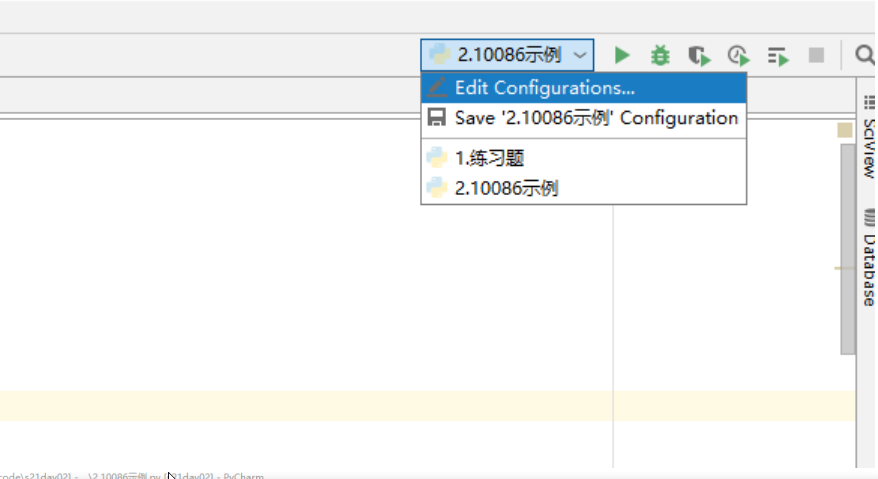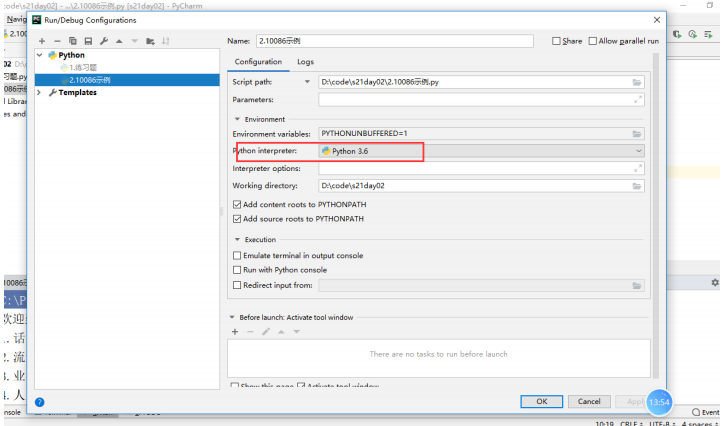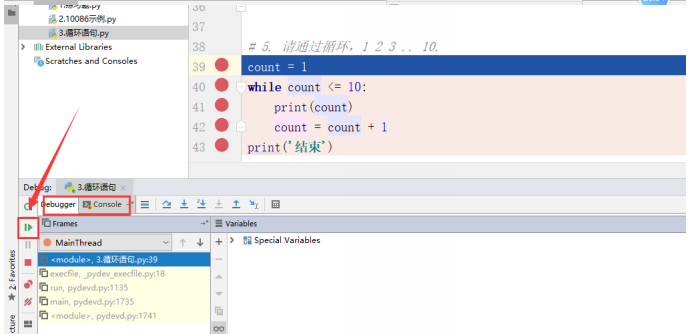python基本语法(二)
message = """欢迎致电10086 1.话费查询; 2.流量服务; 3.业务办理; 4.人工服务 """ print(message) index = input('请输入你要选择的服务:') index = int(index) if index==1: print('话费查询') elif index == 2: print('流量服务') elif index == 3: content = """业务办理 1. 修改密码; 2. 更改套餐; 3. 停机; """ print(content) value = input('请输入要办理的业务:') value = int(value) if value == 1: print('修改密码') elif value == 2: print('更改套餐') elif value == 3: print('停机') else: print('错误') elif index == 4: print('人工服务') else: print('输入错误')
2. pycharm变更解释器


3. 循环语句
1. 循环打印 “人生苦短,我用Python。”
while True: print('人生苦短,我用Python。')

2. while后加入条件
while 1>0 and 2>1: print('人生苦短,我用Python。')
3. 数字相加
""" count = 1 value = count + 1 print(value) """ """ count = 1 count = count + 1 print(count) """
4.请通过循环,让count每次循环都 + 1 .
""" count = 1 while True: print(count) count = count + 1 """ # 练习 """ while True: count = 1 print(count) count = count + 1 """
5. 请通过循环,1 2 3 .. 10.
count = 1 while count <= 10: print(count) count = count + 1 print('结束')
6. 请通过循环,1 2 3 4 5 6 8 9 10.
""" # 错误示例 count = 1 while count <= 10 and count != 7 : print(count) count = count + 1 """ """ # 正确 count = 1 while count <= 6: print(count) count = count + 1 count = 8 while count <= 10: print(count) count = count + 1 """ """ # 正确 count = 1 while count <= 10: if count != 7: print(count) count = count + 1 """ """ # 正确 count = 1 while count <= 10: if count == 7: pass else: print(count) count = count + 1 """
7. break
while True: print(666) break # 终止当前循环 print('结束') # 练习: """ # 通过break实现 1 ~ 10 count = 1 while True: print(count) if count == 10: break count = count + 1 print('结束') """ """ # break是终止当前循环 while True: print('你好') while True: print(666) break break """
8. continue
""" count = 1 while count <=10: print(count) continue # 本次循环如果遇到continue,则不在继续往下走,而是回到while条件位置。 count = count + 1 """ # 示例:1234568910 count = 1 while count <=10: if count == 7: count = count + 1 continue print(count) count = count + 1
9. while else
""" count = 1 while count < 10: print(count) count = count + 1 else: # 不再满足while后的条件时,触发。 或 条件=False print('ELSE代码块') print('结束') """ """ count = 1 while True: print(count) if count == 10: break count = count + 1 else: # 不再满足while后的条件时,触发。 或 条件=False print('ELSE代码块') print('结束') """
10. 其他
-
快速注释 ctrl+?
-
pycharm断点


4. 字符串格式化
1. %s
# 字符串格式化存在的意义 name = input('姓名:') do = input('在干什么:') template = "%s在教室,%s。" %(name,do,) print(template) # 直接做占位符 # template = "我是%s,年龄%s, 职业%s。" %("alex",73,'讲鸡汤',) # print(template)
2. %d
# template = "我是%s,年龄%d, 职业%s。" %("alex",73,'讲鸡汤',) # print(template)
3. %%
# name = 'alex' # template = "%s现在手机的电量是100%%" %(name,) # print(template)
4. 练习
name = input('请输入姓名:') age = input('请输入年龄:') job = input('请输入职业:') hobby = input('请输入爱好:') msg = ''' ------------ info of Alex Li ---------- Name : %s Age : %s job : %s Hobbie: %s ------------- end ----------------''' data = msg %(name,age,job,hobby,) print(data)
5. 运算符
1. 算数运算
# 练习题: 1 ~ 100 之间所有的数相加。 # total = 0 # count = 1 # while count <=100: # total = total + count # count = count + 1 # print(total) # 练习题:打印 1 ~ 100 之间的奇数。 count = 1 while count <= 100: val = count % 2 if val == 1: print(count) count = count + 1
2. 赋值运算
# count = 1 # while count <=100: # print(count) # count +=1 # count = count + 1
3. 逻辑运算
-
一般情况,用于做判断。
if 1 > 0 and 1 > 2: print('666')
-
二般情况,用于做取值。
-
or
""" 对于 or,如果有遇到 value= 1 or 9 第一个值如果是转换成布尔值如果是真,则value=第一值。 第一个值如果是转换成布尔值如果是假,则value=第二值。 如果有多个or条件,则从左到右依次进行上述流程。 示例: v1 = 0 or 1 v2 = 8 or 10 v3 = 0 or 9 or 8 """
-
and
""" 对于and,如果遇到 value= 1 and 9 这种情况 如果第一个值转换成布尔值是True,则value=第二个值。 如果第一个值转换成布尔值是False,则value=第一个值。 如果有多个and条件,则从左到右依次进行上述流程。 示例: v1 = 1 and 9 v2 = 1 and 0 v3 = 0 and 7 v4 = 0 and "" v5 = 1 and 0 and 9 """
-
结合
# 先看and再看or # v1 = 1 and 9 or 0 and 6 # print(v1)
-
其他
-
优先级 在没有()的情况下not 优先级高于 and,and优先级高于or,即优先级关系为( )>not>and>or,同一优先级从左往右计算。
-
数据类型转换
## 小知识 # - int # - str # - bool # 数字转字符串 # v1 = 666 # v2 = str(v1) # 字符串转数字 # v1 = "666" # v2 = int(v1) # 数字转布尔值 # v1 = 0 # v2 = bool(v1) # print(v2) # 字符串转布尔值 # v1 = "" # v2 = bool(v1) # print(v2) # 布尔值转换其他 # v1 = True # v2 = str(v1) # print(v2) # 需要掌握的转换知识点 """ - 字符串转数字 - 数字转字符串 - "" / 0 转换布尔之后是False """
-
-
6. 编码
-
编码扩展
-
ascii
-
unicode
-
ecs2 在以前用两个字节表示一个字符
-
ecs4 现在大部分用四个字节表示一个字符
-
-
utf-8,中文用3字节。
-
utf-16
-
gbk,中文用2字节。
-
gb2312,中文用2字节。
-
-
单位
8bit = 1byte 1024byte = 1KB 1024KB = 1MB 1024MB = 1GB 1024GB = 1TB 1024TB = 1PB 1024TB = 1EB 1024EB = 1ZB 1024ZB = 1YB 1024YB = 1NB 1024NB = 1DB 常⽤到TB就够了
每天学习新的知识,会让自己更加充实

